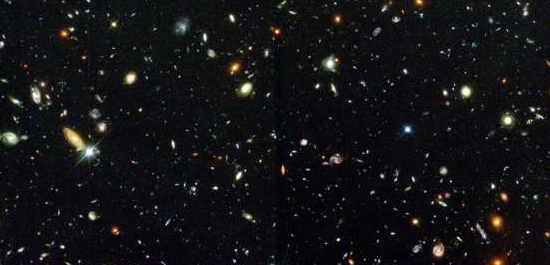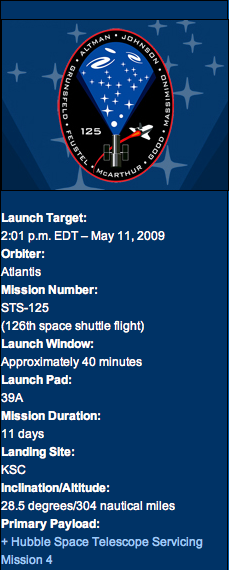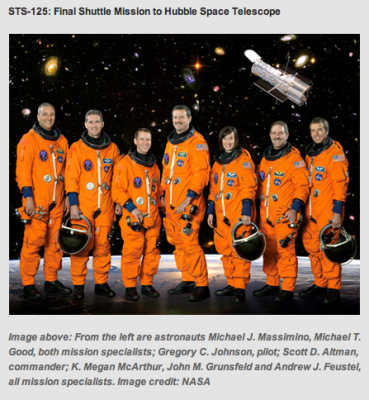8 May 2009
NASA's Most Difficult and Perhaps Most Important Shuttle Mission
Posted by Dan Satterfield
When I was young, if you were an Astronaut, you were famous. Everyone knew what you looked like. Not so anymore. The public fascination with space waned after the Moon landing and it has not recovered. These days, the only way an Astronaut gets famous, is if he dies or gets caught in a sordid love triangle. Astronauts are not household names anymore.
Some of the reasons for this may be the general lack of Science education in this country. Some have called it a war on Science. Based on some emails I get from this journal, I tend to agree with them. It extends beyond climate change, and Biology to almost every facet of Earth Science. Some of the statements I hear political leaders make on Science, are stunningly ignorant of the very basics.
The Astronauts flying on the next Shuttle mission deserve some REAL public recognition. This mission is going to be one of the most difficult and dangerous missions ever attempted by NASA. The previous administrator of NASA (Sean O’Keefe) cancelled it for just that reason, but the public and (especially) the scientific community pushed hard for it to be flown. A new NASA Administrator put it back on the schedule. An article in SCIENCE this week suggests that it was his reluctance to approve the mission led to him being replaced.
I’ve had the privilege of talking with two Apollo Astronauts and even strapped into some simulators. (Zero G movement is easy, as long as you don’t care where you go. Try a task and it’s much more difficult than you can imagine). These Astronauts have trained very hard for these 5 days. The risk of death is about 2% for each Shuttle mission. Would you drive to work tomorrow if you had a 2% chance of dying? I wouldn’t.
They will.

NASA picture of the Hubble Telescope.
You probably know already the task ahead for these Astronauts. They are going to repair the Hubble Space Telescope. No telescope has done more to answer the fundamental questions of Physics since Galileo’s (Which is still working in Italy, but good luck getting to look through it!).
Two new cameras will be added along with fresh batteries and new gyroscopes. The new Wide Field Camera will be 10-30 times more sensitive than the previous one! If it all goes well, Hubble will be astoundingly better than before. It’s hoped that it will last until 2014.
It might still be working when the new James Webb telescope sees it’s first star light. The JWT will be the most advanced telescope ever made and will no doubt make profound discoveries. Testing for this telescope is going on only 9 miles away from where I sit writing this, at NASA’s Marshall Space Flight Center.
This mission will use dozens of tools made especially for the mission. It will indeed be dangerous. Remember that satellite collision awhile back? Well some of that debris is orbiting at around 500km. Where Hubble is. When this flight launches, a rescue Shuttle will be on the pad at KSC, just in case. (Addition May 9th: Former Mission Control Scientist James Oberg wrote more about the rescue possibilities and orbital mechanics on MSNBC’s web site.
It will take multiple space walks to do the job, and NASA has collected the best and the brightest of the “Right Stuff” to do it. Two members of the crew have repaired Hubble before. It will be the last repair mission on Hubble. The Shuttle is about to be retired and when the computers and the gyros fail in about 5 years, Hubble will see no more light from across an unimaginable distance of Space and time.
Just 100 years ago, astronomers thought that the Universe and the Galaxy we inhabit, were one and the same. Those fuzzy spiral “nebula” visible in the best telescopes were thought to be relatively nearby. We really had no idea of just how far away they were and how big the galaxy was. It was Astronomer Edwin Hubble who figured out a way to measure the distance to these galaxies. He used a type of star called Cepheid Variable. He realized that these gave him what astronomers now call a standard candle.

In 1998 Hubble stared at what looked like an empty spot in the sky near the Big Dipper. The 10 day exposure showed millions of galaxies at distances too great to fathom.
Think of it this way. Look at a street light in the far distance. You can tell if it’s near or far, because you know from experience how bright street lights are. If you had some good scientific equipment, you could measure the light from a nearby street light and assuming the distant one is about as bright, you could with some fairly simple math, get a very good estimate of the distance to the far one.
This is exactly what Edwin Hubble did! He found out that these so called nebula were galaxies like our own, but at incredible distances of 250 million light years, and even further. We have now made measurements of galaxies nearly 13 billion light years away. We can only see 13.5 billion light years, because the universe is that old. Light from farther away, could not have reached us yet! (See my previous post on this).
Now we know that we truly are, a grain of sand, in a vast cosmos. There are, however, still fundamental questions to be answered. Most of the universe is invisible to we humans. It’s full of what Cosmologists call dark matter.
What is it?
NOBODY knows. The newly improved Hubble Telescope just might answer that question.
For 7 NASA Astronauts. That’s worth the 2%.
On behalf of Scientists, and Science lovers world wide.
THANK YOU.




 Dan Satterfield has worked as an on air meteorologist for 32 years in Oklahoma, Florida and Alabama. Forecasting weather is Dan's job, but all of Earth Science is his passion. This journal is where Dan writes about things he has too little time for on air. Dan blogs about peer-reviewed Earth science for Junior High level audiences and up.
Dan Satterfield has worked as an on air meteorologist for 32 years in Oklahoma, Florida and Alabama. Forecasting weather is Dan's job, but all of Earth Science is his passion. This journal is where Dan writes about things he has too little time for on air. Dan blogs about peer-reviewed Earth science for Junior High level audiences and up.
I am so excited and hopeful for the crew!
I agree that science is not being supported as it should and often times it’s the parents who must take the lead and add that aspect into a child’s life. As it is with many things now a days, including art and music.
Some people see science as competition or threatening to their religion. That seems to stunt some people’s intellectual growth in the scientific arena.
I love science and God and can easily intertwine the two in my life without compromising either way. Hopefully more people will be able to support science and not be threatened by it. Depending on the physics theory being taught, science even backs up a ‘God’.
This is my first time reading your blog. I find it fascinating and educational. Thank you! I’ll be sharing it with my husband and daughter. I hope you have a good weekend.
Love your blog!
Could you put a link to the post about the age of the universe or maybe the post is about how the light hadn’t reached us yet? I collect good descriptions. Sometimes the same things said slightly different makes all the difference.
Think of it this way. Imagine an object 15 billion light years away. That light has been traveling toward us since the big bang 13.5 billion years ago. It still has 1.5 billion years to go for the light to reach us. So we cannot see it, no matter how good a telescope we build. This actually gets into some fundamental mysteries of cosmology. Current thinking is that the universe must have expanded at greater than the speed of light in the first few milliseconds after the big bang- Cosmologists call it inflation.
These truly are brave people. Lucky to have such a program stationed right here in North Alabama.
Dan, this is the best piece I’ve read yet about the mission later today. Haven’t had time to peruse the archives, but you can be sure it’s now up on my list.
Promoting you on twitter. I’ll send a few folks this way.
You are worth it.
Thanks very much Jon! I have learned to tackle subjects I want to learn more about. Writing a journal can be very educational, especially if you wish to be accurate!